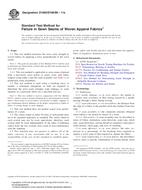Potrebujeme váš súhlas na využitie jednotlivých dát, aby sa vám okrem iného mohli ukazovať informácie týkajúce sa vašich záujmov. Súhlas udelíte kliknutím na tlačidlo „OK“.
ASTM D1683/D1683M-11a
Standard Test Method for Failure in Sewn Seams of Woven Apparel Fabrics (Includes all amendments And changes 12/1/2016).
Automaticky preložený názov:
Štandardná skúšobná metóda pre zlyhanie v všitá švy tkaných tkanín
NORMA vydaná dňa 1.7.2011
Informácie o norme:
Označenie normy: ASTM D1683/D1683M-11a
Poznámka: NEPLATNÁ
Dátum vydania normy: 1.7.2011
Kód tovaru: NS-18063
Počet strán: 9
Približná hmotnosť: 27 g (0.06 libier)
Krajina: Americká technická norma
Kategória: Technické normy ASTM
Kategórie - podobné normy:
Anotácia textu normy ASTM D1683/D1683M-11a :
Keywords:
seam efficiency, seam slippage, sewn seam, sewn seam strength, yarn slippage, woven fabric, Sewn seams, Woven textile fabrics, Failure end point--textile materials/applications, ICS Number Code 59.080.30 (Textile fabrics)
Doplňujúce informácie
| Significance and Use | ||||||||||||
|
This test method can also be used to determine either the sewn seam strength of textiles or the efficiency of a seam assembly with any given fabric. Additionally, the seam strengths of different fabrics can be compared directly by using one of the standard seam assemblies specified in Table 1. Because current information about laboratory precision is incomplete, comparative tests may be advisable. In case of dispute arising from differences in reported test results when using this test method for acceptance testing of commercial shipments, the purchaser and the supplier should perform comparative tests to determine if there is a statistical bias between their laboratories. Competent statistical assistance is recommended for the investigation of bias. As a minimum, the two parties should take a group of test specimens from the same lot of fabric to be evaluated, which utilize a like seam assembly (or standard seam assembly). The test specimens should then be randomly assigned in equal numbers to each laboratory for testing. If a bias is found, either its cause must be determined and corrected, or the purchaser and supplier must agree to interpret future test results in light of the known bias. This test method determines the seam efficiency of a specified seam assembly with each fabric. Because seam efficiency varies with each fabric, one of the standard seam assemblies, as noted in Table 1, should be used when comparing the seam strength of different fabrics. Table 1 lists the default seam assembly specifications to be used for fabrics made with fine, medium and heavy count yarns. If a determination cannot be made as to which seam is the best suited for a particular fabric, all should be evaluated. Seams prepared for this test method should be made by competent factory sewing operators familiar with the potential for damage to the integrity of the sewn seam when stitching is improperly done. (See Note 2.) Note 3—If competent factory sewing operators are not accessible, a laboratory technician familiar with the potential for damage of an improperly sewn seam may prepare the seamed test specimens. It is imperative for purchaser/supplier to understand the impact an improperly sewn seam will have on test results. This test method is applicable whenever a determination of effective sewn seam strength, that is, the optimum seam interaction, is required. The breaking force of the seam and fabric will permit determination of seam efficiency. This test method can aid in determining optimum seam interaction for any given fabric by comparing the properties of the fabric with and without seams. Seam engineering techniques for specific fabric types can also be determined by utilizing this test method. This test method can be used to determine when the sewn seam is affected by seam slippage. While the ultimate consequence of this phenomenon is rupture, seam slippage greater than either the values stated in customer specifications, or as agreed upon by purchaser/supplier may severely reduce the integrity such that the product cannot be used for its intended purpose. (An example of a commonly used seam slippage value is 6 ± 1 mm [0.25 ± 0.04 in.]). |
||||||||||||
| 1. Scope | ||||||||||||
|
1.1 This test method measures the sewn seam strength in woven fabrics by applying a force perpendicular to the sewn seams. Note 1—The grab test procedure in Test Method D5034 shall be used to determine any characteristic in fabric that can affect the measurement of sewn seam strength. 1.1.1 This test method is applicable to sewn seams obtained from a previously sewn article or seams sewn with fabric samples using either a specific seam assembly (see Table 1), or production seam assemblies. 1.2 This test method is used when a breaking force to rupture, a minimum elongation, or both are required to determine the sewn seam strength, seam slippage, or seam integrity of a particular fabric for a specified end use. Note 2—This test method is used in conjunction with Test Method D5034, which is used to measure breaking force and elongation of textile fabrics. Sewn seams in woven fabrics can fail due to rupture, slippage, or any combination thereof. Rupture can be further categorized as failure or fabric, or sewing thread, or seam slippage. 1.3 This test method does not predict actual wear performance of a seam. 1.4 The values stated in either SI units or inch-pound units are to be regarded separately as standard. The values stated in each system may not be exact equivalents; therefore, each system shall be used independently of the other. Combining values from the two systems may result in non-conformance with the standard. 1.5 This standard does not purport to address all of the safety concerns, if any, associated with its use. It is the responsibility of the user of this standard to establish appropriate safety and health practices and determine the applicability of regulatory limitations prior to use. |
||||||||||||
| 2. Referenced Documents | ||||||||||||
|




 Cookies
Cookies
